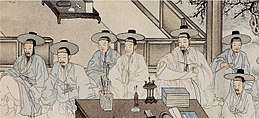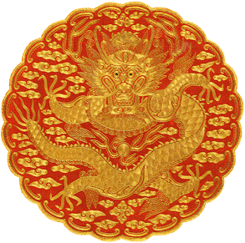Chungin
The chungin, also jung-in, were the upper middle class of the Joseon Dynasty in medieval and early modern Korean society. The name "chungin" directly means "middle people".[1] This privileged class of commoners consisted of a small group of petty bureaucrats and other highly educated skilled workers whose technical and administrative skills enabled the yangban and the royal family to rule the lower classes. Chungin were the lifeblood of the Confucian agrarian bureaucracy, for whom the upper classes depended on to maintain their vice-like hold on the people. Their traditions and habits are the forerunners of the modern Korean administrative systems in both North and South Korea.[2][3]
| Chungin | |
 | |
| Korean name | |
|---|---|
| Hangul | 중인 |
| Hanja | |
| Revised Romanization | jung-in |
| McCune–Reischauer | chung'in |
| Class | Hangul | Hanja | Meaning |
|---|---|---|---|
| Yangban | 양반 | 兩班 | aristocrats |
| Jung-in | 중인 | 中人 | middle people |
| Sangmin | 상민 | 常民 | commoners |
| Cheonmin | 천민 | 賤民 | vulgar commoners |
| • Baekjeong | 백정 | 白丁 | untouchables |
| • Nobi | 노비 | 奴婢 | slaves or serfs |
| V・T | |||
Professions and roles in the society

In dynastic Korea, particularly during the Joseon period, the chungin were lower than the yangban aristocracy but above the lower middle and working class commoners in social status. They included highly educated government-employed specialists with a status comparable to modern white collar workers (e.g. interpreters, scientists, engineers, physicians, jurists, astronomers, accountants, calligraphers, and musicians), military officers from or had marriage ties to the families producing technical specialists, hereditary government functionaries (both capital and local), and illegitimate children of aristocrats.[4][5]
In everyday life, the chungin were below the aristocratic yangban but superior to the lower middle and working class sangmin. Their roles were minor technical and administrative officials who supported the structure of the government. The highest-ranking chungin, local functionaries, administratively enabled the yangban to oppress the lower classes, especially the total control they had over the sangmin. The chungin functioned as the middle-class and were essentially petty bureaucrats in the rural areas especially.
Although inferior to the aristocracy in social standing, the highly educated chungin enjoyed far more privileges and influence than the lower middle and working class commoners. For example, the chungin were not taxed nor subject to military conscription. Like the yangban, they were allowed to live in the central part of the city, hence the name "middle people". Also, the chungin tended to marry within their own class as well as into the yangban class. In addition, since they were eligible to enter the palace as royal servants, it was possible for a chungin girl, if her father had a clean reputation or good connections and she was able to catch the king or Queen Dowager's good eye, to become a royal consort or even a Royal Noble Consort, the third highest level in the hierarchy of the king's harem, after the Queen Dowager and the queen. An example is Royal Noble Consort Hee of the Jang clan, mother of Gyeongjong.
However, to become a chungin, passing the chapkwa examination, which tested their practical knowledge of certain skills, was usually required. The chungin besides being known as a section of the middle-class, they were the smallest social class in dynastic Korea.
The Korean chungin, as a social class, were roughly analogous to the middle-class in Europe. Local functionaries in the rural areas were basically equal to petty bureaucrats.
Famous chungin
Chungin were prominent especially in the late nineteenth and early twentieth centuries when they tended to welcome Western institutions and ideas for modernizing Korea.
- Yu Daechi (a.k.a. Yu Honggi)
- O Gyeongsok and his son O Sechang, Byeon Su, Kim Gyusik and Choe Nam-seon.
See also
- Baekjeong
- Cheonmin
- Daeryeong Suksu
- Joseon Dynasty
- Sangmin
- Yangban
References
- Andrea Matles Savada (1997). South Korea: A Country Study. DIANE Publishing. pp. 91, 377. ISBN 0-7881-4619-X.
- 중인 (中人) (in Korean). Empas / EncyKorea.
- 중인 (中人) (in Korean). Empas / Britannica.
- Ivor Grattan-Guinness (2003). Companion Encyclopedia of the History and Philosophy of the Mathematical Sciences. JHU Press. pp. 112–113. ISBN 0-8018-7396-7.
- Chun-gil Kim (2005). The History of Korea. Greenwood Publishing Group. pp. 95–96–113. ISBN 0-313-33296-7.
chungin.
